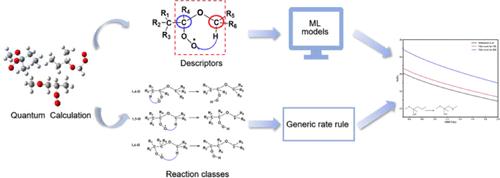结合机器学习和量子化学增强醚过氧自由基分子内h迁移反应的预测动力学:一般速率规则和机器学习技术的比较研究
IF 3.9
3区 工程技术
Q2 ENGINEERING, CHEMICAL
引用次数: 0
摘要
准确的反应速率常数对于自动机制生成器是必不可少的,然而高水平的量子化学方法仍然在计算上令人望而却步。这项研究解决了醚过氧自由基分子内h迁移的挑战,这在低温燃烧机制中很重要。利用M06-2X/6-311++G(2df,2p)计算和典型跃迁态理论研究了102个反应。虽然我们为42个反应类别制定了通用的速率规则,但事实证明它们不足以进行准确的预测。因此,我们建立了带有特定反应描述符的机器学习模型来预测速率常数。我们比较了基于树的算法(极端梯度增强和光梯度增强机)和非基于树的算法(多元线性回归和高斯过程回归)。光梯度增强机以ln k值的均方根误差为0.396的优势脱颖而出。特征重要性和SHapley加性解释分析表明,结构特性和能量特性是影响反应速率的主要因素。我们的系统比较表明,机器学习方法明显优于醚过氧自由基h迁移反应动力学建模的一般速率规则。本文章由计算机程序翻译,如有差异,请以英文原文为准。

Enhancing the Predictive Kinetics of Intramolecular H-Migration Reactions of Ether Peroxy Radicals by Integrating Machine Learning with Quantum Chemistry: A Comparative Study of Generic Rate Rules and Machine Learning Techniques
Accurate reaction rate constants are essential for automated mechanism generators, yet high-level quantum chemistry methods remain computationally prohibitive. This study addresses this challenge for intramolecular H-migration in ether peroxy radicals, which are important in low-temperature combustion mechanisms. We investigated 102 reactions using M06-2X/6-311++G(2df,2p) calculations and canonical transition state theory. While we developed generic rate rules for 42 reaction classes, they proved inadequate for accurate predictions. Therefore, we built machine learning models with reaction-specific descriptors to predict the rate constants. We compared tree-based algorithms (eXtreme Gradient Boosting and Light Gradient Boosting Machine) against nontree-based algorithms (Multivariate Linear Regression and Gaussian Process Regression). The Light Gradient Boosting Machine emerged as superior with a root mean square error of 0.396 in ln k values. Feature importance and SHapley Additive exPlanation analysis revealed that structural characteristics and energetic properties were the most influential factors affecting reaction rates. Our systematic comparison demonstrates that machine learning methods significantly outperform generic rate rules for kinetic modeling of ether peroxy radical H-migration reactions.
求助全文
通过发布文献求助,成功后即可免费获取论文全文。
去求助
来源期刊

Industrial & Engineering Chemistry Research
工程技术-工程:化工
CiteScore
7.40
自引率
7.10%
发文量
1467
审稿时长
2.8 months
期刊介绍:
ndustrial & Engineering Chemistry, with variations in title and format, has been published since 1909 by the American Chemical Society. Industrial & Engineering Chemistry Research is a weekly publication that reports industrial and academic research in the broad fields of applied chemistry and chemical engineering with special focus on fundamentals, processes, and products.
 求助内容:
求助内容: 应助结果提醒方式:
应助结果提醒方式:


